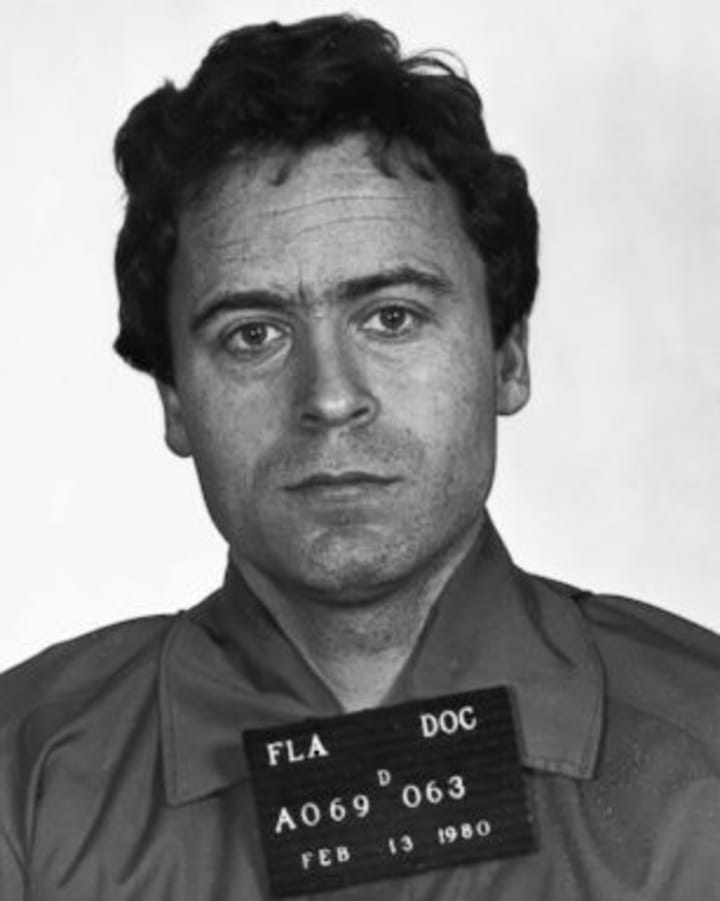Content warning
This story may contain sensitive material or discuss topics that some readers may find distressing. Reader discretion is advised. The views and opinions expressed in this story are those of the author and do not necessarily reflect the official policy or position of Vocal.
The Charming Monster: unmasking Ted Bundy.
A Terrifying Tale of Deception, Devastation and Dark Depths of Serial Killer's Mind.

In the annals of true crime, one name stands out like a chilling specter—Ted Bundy. With his charming demeanor and handsome appearance, Bundy became one of the most infamous serial killers in American history, leaving a trail of terror and devastation in his wake.
Born Theodore Robert Bundy on November 24, 1946, in Burlington, Vermont, Bundy grew up in a seemingly ordinary middle-class family. Intelligent and charismatic, he excelled academically and was well-liked by those around him. However, beneath the facade of normalcy, a sinister darkness lurked.

Bundy's first known murders occurred in the early 1970s when young women began disappearing in the Pacific Northwest. He would approach his victims under the guise of needing assistance or feigning injury, using his charm to disarm them before subduing and ultimately ending their lives. His modus operandi involved a mix of abduction, rape, and brutal violence, leaving a trail of horrifying crime scenes that baffled investigators.
Despite being the prime suspect in several cases, Bundy eluded capture for years. He possessed a unique ability to blend into society, leading a seemingly normal life while continuing his predatory activities. His charisma and manipulative skills allowed him to maintain relationships, even as he engaged in his murderous spree.
As the body count rose, Bundy's brazenness escalated. He began venturing to different states, leaving a path of destruction in his wake. The media dubbed him a "charming monster," a fitting description for the man who could seamlessly shift between his public persona and his sadistic alter ego.
Bundy's reign of terror came to a halt in 1978 when he was finally apprehended in Florida. Initially arrested for a traffic violation, he soon became a prime suspect in a series of abductions and murders in the area. The evidence against Bundy was overwhelming, and he was eventually convicted for the deaths of several young women.
While on death row, Bundy captivated the public's attention once again. He utilized his charm and manipulative skills to garner sympathy and even attempted to represent himself during his trial, prolonging the proceedings and drawing national media coverage. Bundy's case became a morbid fascination for many, as the public struggled to comprehend the mind of a man capable of such heinous acts.

On January 24, 1989, Ted Bundy was executed in the electric chair at Florida State Prison. His crimes had claimed the lives of at least 30 young women across multiple states, but the true number may never be known. Bundy's legacy remains a haunting reminder of the depths of human depravity and the chilling allure of a charismatic killer.
As the story of Ted Bundy unfolds, it becomes increasingly apparent that his depravity knew no bounds. During his incarceration, Bundy offered glimpses into the twisted mind that drove his heinous acts. He engaged in chilling interviews and provided limited details about his crimes, taunting investigators and the public with tantalizing hints of the horrors he had inflicted upon his victims.
Bundy's case brought attention to the concept of a "serial killer" and the study of criminal profiling. Psychologists and criminologists delved into his psyche, attempting to understand the factors that shaped such a monster. The exploration of Bundy's childhood, possible traumas, and psychological makeup became a subject of intense analysis, seeking answers to the age-old question of what creates a monster.
Moreover, Bundy's case shed light on the devastating impact his crimes had on the families of his victims. The anguish and heartbreak they endured were immeasurable, compounded by the media circus surrounding Bundy's trial. For the loved ones left behind, his execution provided a sense of closure, albeit tinged with the everlasting pain of loss.
Decades later, Bundy's name continues to be synonymous with evil and the horrors of serial murder. His story has inspired countless books, documentaries, and movies, cementing his status as a dark legend in the realm of true crime. Yet, amidst the fascination and morbid intrigue, it is crucial to remember the victims—the lives cut tragically short and the families forever scarred by his actions.
Ted Bundy serves as a chilling reminder that evil can often hide behind a charming facade. His legacy forces us to confront the unsettling truth that monsters can walk among us, masquerading as ordinary individuals. The story of Ted Bundy stands as a haunting cautionary tale, reminding us of the depths of human darkness and the importance of vigilance in the face of hidden evil.
The story of Ted Bundy serves as a cautionary tale, reminding us that evil can wear a captivating mask. It compels us to remain vigilant and to recognize that beneath the charm and charisma may lie a darkness that should never be underestimated
About the Creator
emad afsary
Hi, this is emad and i'm very passionate about writing stories. Hope i will give my best to the audience.






Comments
There are no comments for this story
Be the first to respond and start the conversation.